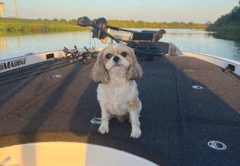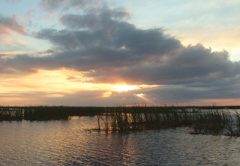by Ly Nguyen
December in Highlands County usually brings our first taste of Winter’s cold temperatures. As these cold fronts push through, lake temperatures will fluctuate and our local fishing can be greatly impacted. Depending on the severity of the winter, lake temperatures can fall into the 50’s, which is a far cry from the upper 80’s and 90’s of summer time.
Florida Largemouth Bass generally enjoy moderate temperatures and the slow moving waters of our lakes and rivers. In Highlands County we have two types of lakes, deep water lakes and shallow water lakes. Both lakes offer vast amounts of shelter in the way of vegetation, rocks, over hanging cliffs, sunken trees, logs, brush piles as well as docks. These environments offer excellent cover and food that enables bass to grow very quickly over their northern counterparts.
During December our shallower lakes such as Istokpoga and Josephine will continue to have fish feeding in their typical fall pattern but the deeper lakes will change somewhat. In lakes such as Lake Placid (Childs) the bass begin moving from the deeper ledges and structure to the shallower, warmer waters nearer shore. During this period the bass are transitioning to or may have begun to spawn. If air and lake temperatures remain warm then this movement will not be as pronounced. But don’t worry for unlike northern large mouths, the Florida Largemouth spawn for several months and the fluctuation in temperatures only prolongs the spawn. If the fish in your area lake are still in pre-spawn then the fishing results can still be very good with more catches on moving baits. The first cold front that drops the air and water temperatures will slow the fish down.
Experienced Florida Largemouth Bass anglers recommend using a topwater bait such as a Cotton Cordell Boy Howdy in silver with black back or similar style prop-topwater bait. The best way to move this lure through the water is through a steady retreive and the occasional twitch and pause as it is move through the weeds. The front and rear propeller helps this lure move through the weeds effectively.
For calm days on the lake, use a long Rapala with small twitches and pauses. Once you get a strike, set the hook immediately as the Florida Largemouth Bass usually swallow the lure in one gulp. However, if a breeze picks up, switch to a buzz bait with a white skirt, a trailer hook and trailer. Once you get a strike, give a second or two before setting the hook.
For most lakes, the color scheme should be black and blue at night or cloudy conditions and white or chartreuse for the day.
Spinnerbaits are effective lake lures in weeds, grass and timber locations where there is a light wind. Try using a silver Colorado blade towards the front followed by a larger gold willow leaf in the back. The best weight to use is a 1/4 to 3/8 ounce. If you happen to use a double Colorado blade, use a skirt color of chartreuse. However, when working over weeds and grass, maintain a steady retrieve and set the hook immediately upon a strike.
Cold fronts have a direct impact on lake fishing in Florida. During November, cold fronts stimulate the Florida Largemouth Bass to feed. These fronts usually result in cooler water surface temperatures, which is conducive to catching bass on the surface with rattletraps and crankbaits. However, once the temperatures drop down below 70-degrees, switch to crankbaits and Carolina style presentations.
Once December arrives, the cold fronts cool the water to the mid to high 50’s in Central Florida, and like bass everywhere, the Florida Largemouth Bass becomes inactive. The best way to catch them in these months is using lures that appeal to their sense and will irritate them.
Buzz baits, spinner baits and spoons are all very effective lures at creating vibrations and annoying Florida largemouth bass. Just make sure that you cast your bait within a few feet of the bass.
The crappie reports have been consistent and Lake Istokpoga seems to be the go to place. I was recently out there and as many as 30 boats scattered across the lake drifting for the tasty fish. Most anglers seem to be reporting the catches on a mix of live minnows, jigs or jigs with minnow trailing. Others find success with trolling for them. I honestly prefer a natural drift letting the breeze move the boat. Ideally if drifting, a speed of less then 0.8MPH seems to be most productive. Other local lakes with decent reports of Crappie catches include Little Lake Jackson, Lake Josephine, Lake Sebring and Lake Arbuckle.
Good Luck and see you on the water.
by Ly Nguyen






